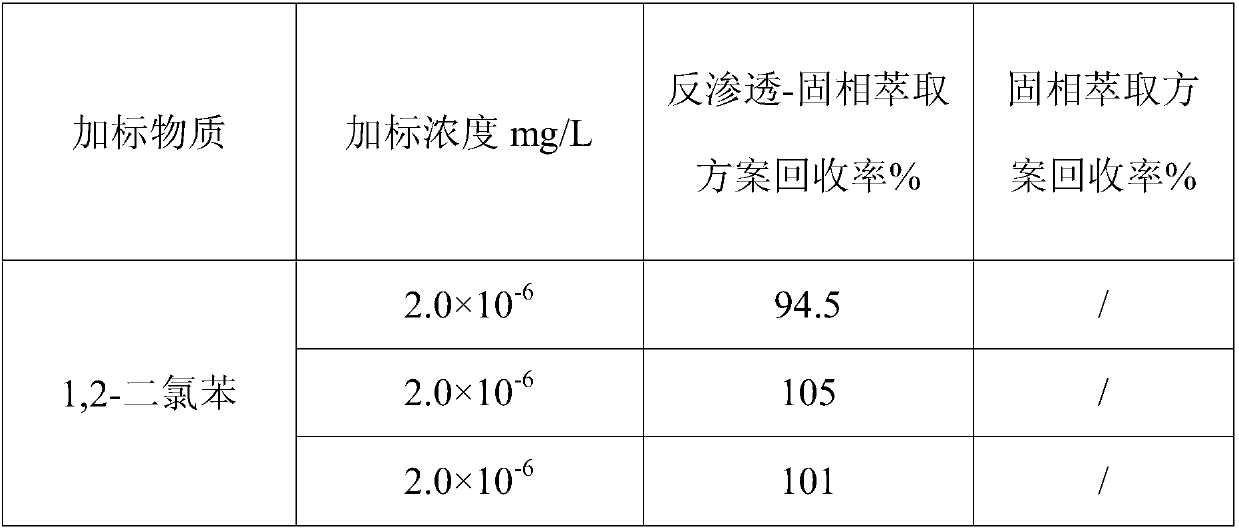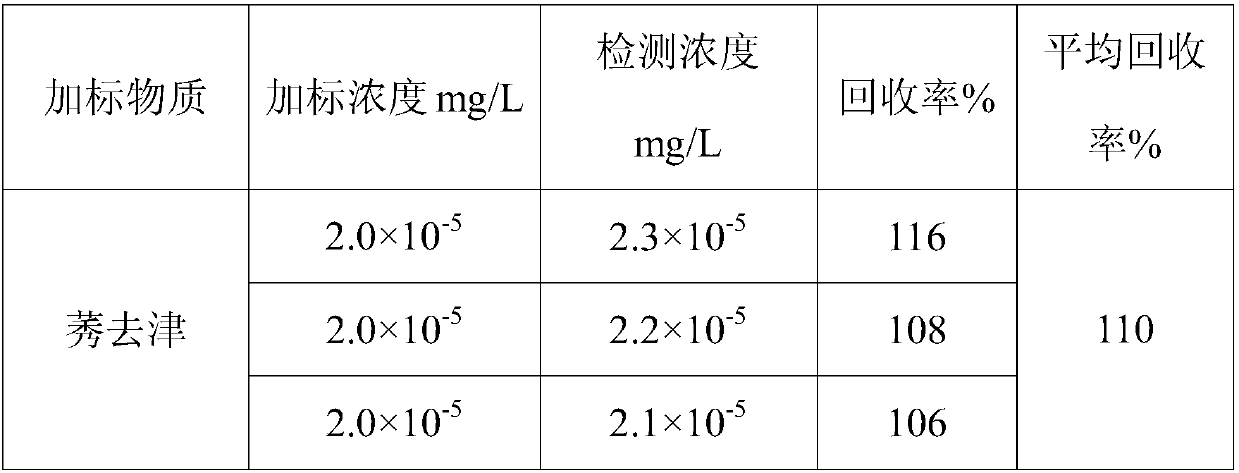Detection method of trace persistent organic pollutants in water
A technology of organic pollutants and detection methods, applied in the field of analysis and detection, can solve the problems that trace organic matter cannot be effectively carried out, and achieve the effect of high concentration of water samples, reduction of losses, and improvement of enrichment efficiency
- Summary
- Abstract
- Description
- Claims
- Application Information
AI Technical Summary
Problems solved by technology
Method used
Image
Examples
Embodiment 1
[0024] Experimental water quality: laboratory pipe network water samples, through the following steps to detect POPs in laboratory pipe network water.
[0025] Take 20L of high-purity water, pump it into the water tank of the reverse osmosis device, turn on the water pump circulation, the circulation flow rate is 6LPM, and after 10 minutes of circulation, open the concentrated water valve to release the enriched concentrated water containing protective liquid and impurities. Repeat the cleaning 4 times until the reverse osmosis membrane is cleaned.
[0026] Take 100L of faucet water from the laboratory pipe network, pour it into the reverse osmosis water tank, and start the reverse osmosis cycle of the water sample, with a circulation rate of 8LPM. When about 3L of water sample remains in the reverse osmosis water tank, the circulation is stopped, the enriched concentrated water is released from the concentrated water valve, and the measuring cylinder is quantified. Repeat th...
Embodiment 2
[0036] Comparison experiment between reverse osmosis-solid phase extraction technology and single solid phase extraction technology, experimental water quality: laboratory pipe network water spiked with 1,2-dichlorobenzene, spiked concentration: 2×10 -6 mg / L, the spiked water samples were measured in parallel three times.
[0037] (1) Reverse osmosis-solid phase extraction water sample treatment:
[0038] Take 20L of high-purity water, pump it into the water tank of the reverse osmosis device, turn on the water pump circulation, the circulation flow rate is 6LPM, and after 10 minutes of circulation, open the concentrated water valve to release the enriched concentrated water containing protective liquid and impurities. Repeat the cleaning 4 times until the reverse osmosis membrane is cleaned.
[0039] Take 100L of faucet water from the laboratory pipe network. After the water sample is spiked, put it into the reverse osmosis water tank, and start the reverse osmosis cycle of ...
Embodiment 3
[0054] Experimental water quality: laboratory pipe network water 1,2,3-trichlorobenzene, 1,3,5-trichlorobenzene spiked, spiked concentration: 2×10 -5 mg / L, the spiked water samples were measured in parallel three times. The water sample reverse osmosis treatment and detection steps are the same as in Example 1.
[0055] Take 20L of high-purity water, pump it into the water tank of the reverse osmosis device, turn on the water pump circulation, the circulation flow rate is 6LPM, and after 10 minutes of circulation, open the concentrated water valve to release the enriched concentrated water containing protective liquid and impurities. Repeat the cleaning 4 times until the reverse osmosis membrane is cleaned.
[0056] Take 100L of faucet water from the laboratory pipe network. After the water sample is spiked, put it into the reverse osmosis water tank, and start the reverse osmosis cycle of the water sample, and the cycle flow rate is 8LPM. When about 3L of water sample remai...
PUM
| Property | Measurement | Unit |
|---|---|---|
| area | aaaaa | aaaaa |
| recovery rate | aaaaa | aaaaa |
| recovery rate | aaaaa | aaaaa |
Abstract
Description
Claims
Application Information
 Login to View More
Login to View More - R&D
- Intellectual Property
- Life Sciences
- Materials
- Tech Scout
- Unparalleled Data Quality
- Higher Quality Content
- 60% Fewer Hallucinations
Browse by: Latest US Patents, China's latest patents, Technical Efficacy Thesaurus, Application Domain, Technology Topic, Popular Technical Reports.
© 2025 PatSnap. All rights reserved.Legal|Privacy policy|Modern Slavery Act Transparency Statement|Sitemap|About US| Contact US: help@patsnap.com



